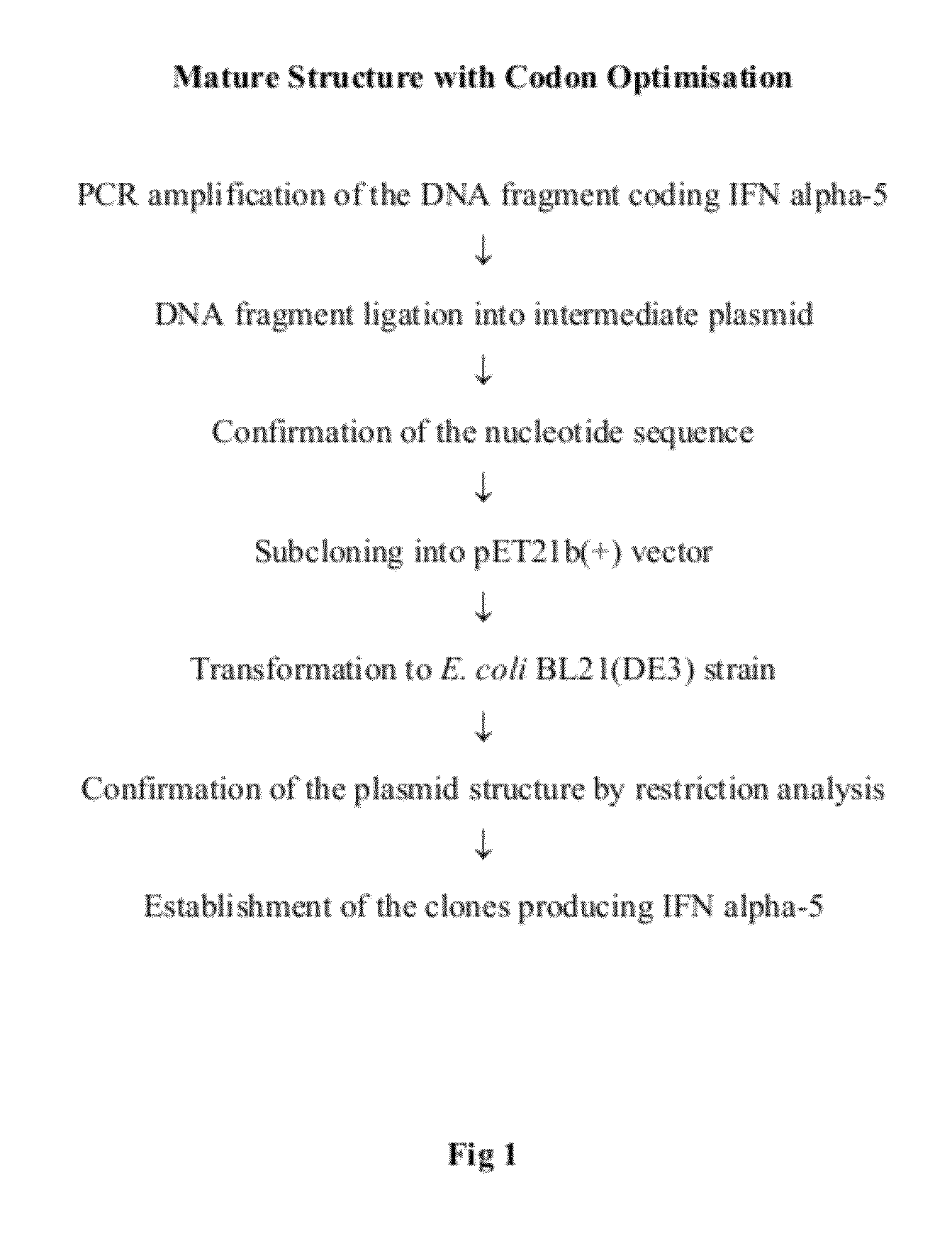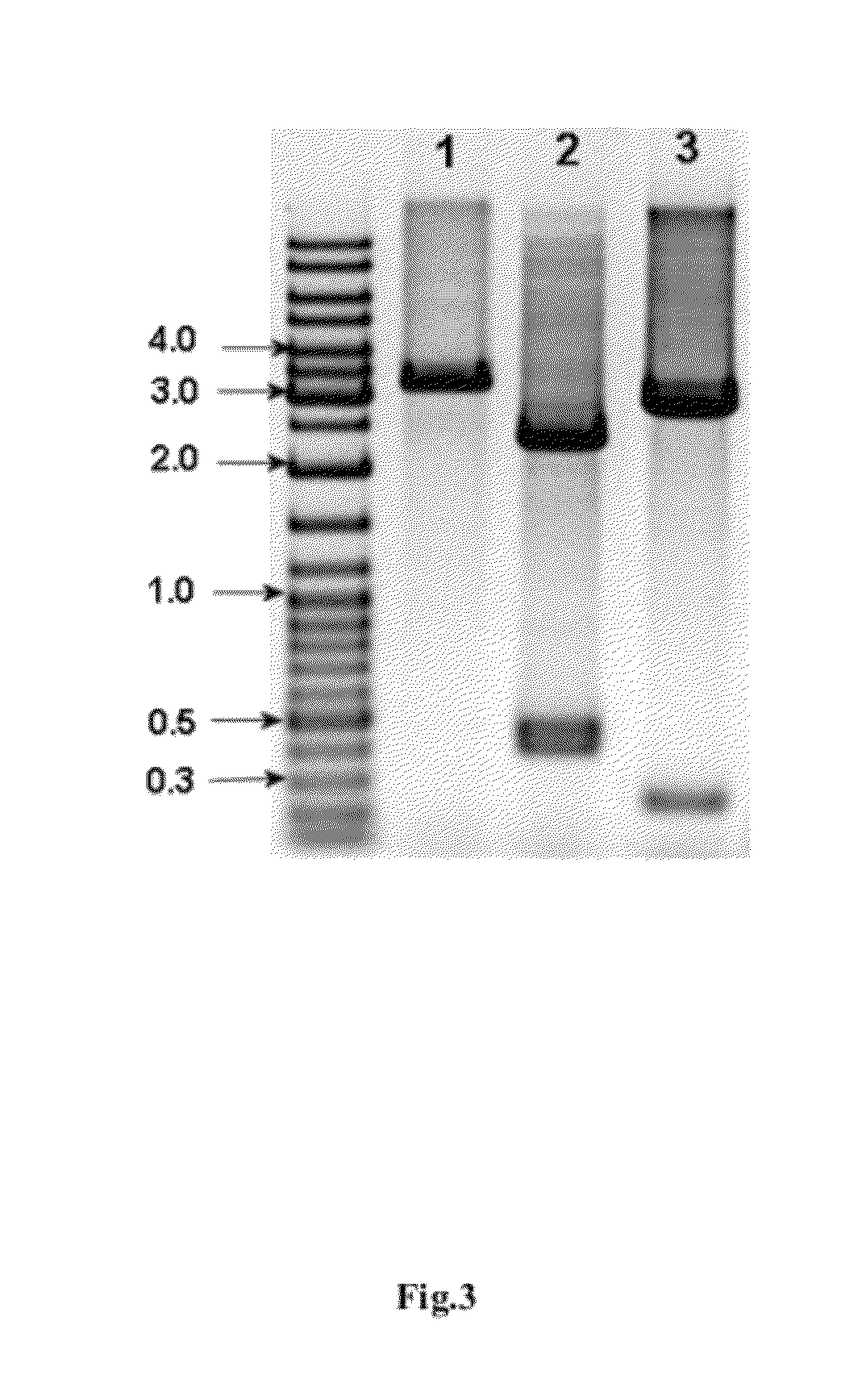Method for producing interferon alpha 5
a technology of interferon and alpha 5, which is applied in the field of process for producing interferon alpha 5 (ifna5) protein, can solve the problems of e. coli expression of ifns, which shows some problems, and achieves the effects of reducing the generation of oxidized species, and reducing the incorporation of extra methionine residues
- Summary
- Abstract
- Description
- Claims
- Application Information
AI Technical Summary
Benefits of technology
Problems solved by technology
Method used
Image
Examples
example 1
Construction of the E. coli Strain Expressing IFNa5
[0094]This example discloses the development and construction of the E. coli strain producing recombinant human interferon alpha-5 (hIFNa5). Briefly, the cloning and expression of the hIFNa5 gene and the construction of the bacterial strain producing recombinant IFNa5 protein was achieved as described below by using the following steps: cloning of the cDNA gene encoding hIFNa5, modification of the DNA sequence of said gene to optimize its expression in E. coli, construction of the expression plasmid, transformation of the selected plasmid into a suitable E. coli strain and selection of expression / induction conditions.
Methods
[0095]Conventional methods and protocols were used in cloning and expression of hIFNa5 [Sambrook et al. Molecular cloning: A Laboratory Manual. Second ed., CSH Laboratory, Cold Spring Harbor, 1989; Current Protocols in Molecular Biology, vol. 1-3 (Ausubel F. M. et al., ed.) John Wiley & Sons, Inc., Brooklyn, N.Y....
example 2
Biosynthesis Process of hIFNa5 by a Producing Strain
[0112]The E. coli BL21 (DE3) pET21-IFN a-5 strain (Example 1) was cultivated in a media having the following composition (g / L):[0113]a) for inoculum preparation (cultivation) in the flasks (g / L): di-sodium hydrogen phosphate (17.0), potassium dihydrogen phosphate (1.82), ammonium sulfate (3.0), magnesium sulfate heptahydrate (0.5), D(+)-glucose monohydrate (15.0) and microelements stock solution e) (0.16 mL);[0114]b) for fermentation (g / L): ammonium phosphate dibasic (4.0), magnesium sulfate heptahydrate (0.5), potassium dihydrogen phosphate (13.3), citric acid monohydrate (1.6), D(+)-glucose monohydrate (30.0) and microelements stock solution e) (0.25 mL);[0115]c) feeding solution A (g / L): D(+)-glucose monohydrate (700.0), magnesium sulfate heptahydrate (20.7) and microelements stock solution e) (3.4 mL / L);[0116]d) feeding solution B (g / L): ammonium phosphate dibasic (360.0) and potassium dihydrogen phosphate (306.7); and[0117]e) ...
example 3
Process for Isolating and Purifying hIFNa5 from a Producing Strain
1. Biomass Homogenization, Disruption and Isolation of Inclusion Bodies (IBs)
[0124]680.0-700.0 g of the biomass obtained in Example 2 was homogenized in a resuspension buffer (0.1 M Tris-HCl, pH 7.80-8.00, containing 2 mM EDTA, 0.1% TritonX-100 and 1 mM PMSF) at a 1 / 10 (w / v) ratio, i.e., 1 g of wet biomass / 10 mL of resuspension buffer.
[0125]Resuspension was performed in a Poter's homogenizer (Teflon / glass) and then cells were disrupted with a high pressure homogenizer at 600-800 bar at 4-10° C. temperature. After cells desintegration, inclusion bodies (IBs) were separated by centrifugation at 8,000 rpm over 30-35 min.
2. Washing of Inclusion Bodies (IBs)
[0126]Pre-washing of isolated IBs was performed by a four consecutive-step process with washing buffers I-III:[0127]Washing buffer I: 10 mM Tris-HCl buffer, pH 7.45-7.55, containing 1 M NaCl, 0.1% Polysorbate—80;[0128]Washing buffer II: 10 mM Tris-HCl buffer, pH 8.00-8....
PUM
| Property | Measurement | Unit |
|---|---|---|
| volume | aaaaa | aaaaa |
| volume | aaaaa | aaaaa |
| pH | aaaaa | aaaaa |
Abstract
Description
Claims
Application Information
 Login to View More
Login to View More - R&D
- Intellectual Property
- Life Sciences
- Materials
- Tech Scout
- Unparalleled Data Quality
- Higher Quality Content
- 60% Fewer Hallucinations
Browse by: Latest US Patents, China's latest patents, Technical Efficacy Thesaurus, Application Domain, Technology Topic, Popular Technical Reports.
© 2025 PatSnap. All rights reserved.Legal|Privacy policy|Modern Slavery Act Transparency Statement|Sitemap|About US| Contact US: help@patsnap.com



